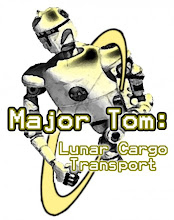VASIMR - VASIMR or Variable Specific Impulse Magnetoplasma Rocket, is a low thrust electric propulsion engine, that is currently being designed and tested by AdAstra Rocket Company. It provides continuous low thrust to gradually increase it and the Cargo Capsule's orbit around Earth until it is captured by the Moon. This means that the trip time is significant, but time is not as important a factor since these are unmanned missions. The low thrust also means we are using our fuel as efficiently as possible. We were fortunate enough to collaborate with a current employee of AdAstra who is also an alum of our degree program at the University of Wisconsin-Madison.
Cargo Capsule - The Cargo Capsule houses both the payload going to the Moon and chemical fuel for all three crafts. The fuel types include methane, oxygen, helium, and argon. This fuel is distributed to the two separate spacecrafts via docking mechanisms that incorporate fuel transfer. Payload is stored in Releasable Cargo Pallets (RCPs) that accommodate the cargo offloading once on the Lunar surface. Currently designed robotic arms for the Constellation Program have the ability to grasp each RCP, which there are two of for every Cargo Capsule, for transport on the Lunar surface. The Cargo capsule also features deployable landing gear based on Apollo-era Lunar landers.
Lunar Lander - The Lunar Lander's general responsibilities include taking the Cargo Capsule out of orbit around the Moon to the Lunar surface. It lacks any sort of landing gear since it is positioned on top of the Cargo Capsule while landing. In order to provide thrust, the Lunar Lander has two deployable trusses with a thruster on each. This not only allows thrust to be provided without damaging the Cargo Capsule, but also to allow stowing of the trusses during its launch from Earth. The descent and landing are automated by a precise guidance system incorporating various cameras and sensors. The Lunar Lander will relaunch without the Cargo Capsule, but only after it is refueled by liquid oxygen extracted from the Lunar surface.

Above you can see the three separate spacecrafts and then a visual overview of the mission divided into the "First Trip" where we launch everything and the "Main Cycle" where we only launch subsequent Cargo Capsules. LEO and LLO represent Low Earth Orbit and Low Lunar Orbit, respectively.
Stay tuned for more posts, especially as we approach our presentation at the PISCES Conference in Hilo, Hawaii, with our official departure date being Tuesday, Feb 9th!

